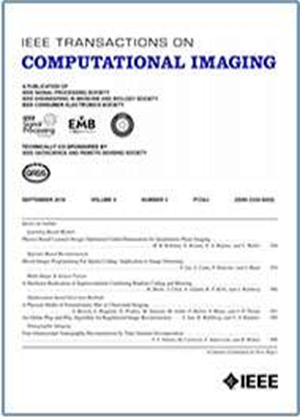Full Matrix Wavefield Migration for Layered Photoacoustic Imaging
IF 4.8
2区 计算机科学
Q2 ENGINEERING, ELECTRICAL & ELECTRONIC
引用次数: 0
Abstract
Medium heterogeneity poses a severe challenge to image reconstruction in transcranial photoacoustic tomography, which cannot be fully addressed by the homogeneous phase shift migration method. Although the existing methods can enhancethe imaging quality to a certain extent, they are limited by the large approximation errors and low computational efficiency. To further improve imaging performance and calculation speed, this paper proposes full matrix wavefield migration, which takes into account both lateral and longitudinal variations of speed of sound (SOS). Unlike the PSM method which relies on a layer-by-layer migration framework, the proposed approach reformulates the SOS map across the propagation medium into a spatial matrix of SOS. By means of extrapolating wavefield data in the wavenumber domain and correcting phase deviations in the spatial domain, this method reduces the image distortion caused by SOS irregularity and suppresses artifacts in reconstructed images. Moreover, the calculation process is further optimized to eliminate redundancy. Simulation and experimental results demonstrate that full matrix wavefield migration method improves lateral resolution (up to 21.24%) and computational efficiency (about 19.84%) compared to the previous methods.层状光声成像的全矩阵波场偏移
介质的非均质性对经颅光声断层成像的图像重建提出了严峻的挑战,均匀相移迁移方法无法完全解决这一问题。现有的方法虽然能在一定程度上提高成像质量,但存在近似误差大、计算效率低等问题。为了进一步提高成像性能和计算速度,本文提出了考虑声速横向和纵向变化的全矩阵波场偏移。与依赖于逐层迁移框架的PSM方法不同,该方法将跨传播介质的SOS地图重新表述为SOS的空间矩阵。该方法通过在波数域中外推波场数据,在空间域中修正相位偏差,降低了SOS不规则性引起的图像畸变,抑制了重建图像中的伪影。进一步优化计算过程,消除冗余。仿真和实验结果表明,与现有方法相比,全矩阵波场偏移方法提高了横向分辨率(21.24%)和计算效率(19.84%)。
本文章由计算机程序翻译,如有差异,请以英文原文为准。
求助全文
约1分钟内获得全文
求助全文
来源期刊

IEEE Transactions on Computational Imaging
Mathematics-Computational Mathematics
CiteScore
8.20
自引率
7.40%
发文量
59
期刊介绍:
The IEEE Transactions on Computational Imaging will publish articles where computation plays an integral role in the image formation process. Papers will cover all areas of computational imaging ranging from fundamental theoretical methods to the latest innovative computational imaging system designs. Topics of interest will include advanced algorithms and mathematical techniques, model-based data inversion, methods for image and signal recovery from sparse and incomplete data, techniques for non-traditional sensing of image data, methods for dynamic information acquisition and extraction from imaging sensors, software and hardware for efficient computation in imaging systems, and highly novel imaging system design.
 求助内容:
求助内容: 应助结果提醒方式:
应助结果提醒方式:


